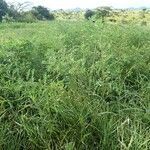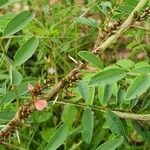Erect to spreading, perennial herb or shrub to 3 m high; young stems ridged, strigose with dense, appressed, equally biramous hairs. Leaves pinnate, to 17 cm long, with 11–17 leaflets; stipules triangular, 1.5–3 mm long, pubescent; petiole 10–18 mm long; rachis furrowed; leaflets opposite, glabrous above, sparsely appressed-hairy below, obovate to oblong, 15–28 mm long, 3.5–9 mm wide, apex obtuse and very shortly mucronate. Inflorescences (1.2–) 2.5–8 cm long, shorter than leaves; peduncle 2–4 mm long; bracts triangular, 0.5 mm long; pedicel 0.5–1.2 mm long; flowers pink to reddish. Calyx 1–1.2 mm long, lobes triangular, about as long as the tube, clothed with moderately dense, white or grey, appressed hairs. Standard broadly elliptical, 4–4.5 mm high, 3.3–3.5 mm wide. Wings spathulate, 3.5–4 mm long, 1–1.3 mm wide. Keel 4.3–4.5 mm long, 1.3–1.5 mm deep; apex rounded; lateral pockets 0.5–0.8 mm long. Staminal tube 3–3.7 mm long, colourless. Ovary appressed-hairy. Pods descending, terete, 15–25 mm long, 2–2.5 mm deep, brown; hairs sparse to moderately dense, appressed; apex shortly pointed; endocarp faintly spotted; seeds 4–7 per fruit.
Stout rather woody herb 1–2 or rarely up to 3 m. tall; stems somewhat ridged, rather densely strigulose, the hairs white or brown.. Stipules subulate-setaceous, 2–9 mm. long; rhachis strigulose, up to 6 cm. long, including a petiole of up to 15 mm., prolonged 1–3 mm. beyond lateral leaflets; stipellae subulate, under 1 mm. long; petiolules ± 1 mm. long; leaflets 7–17, narrowly elliptic-oblong, up to 2 cm. long and ± 7 mm. wide, strigulose beneath, usually glabrous above.. Racemes many-flowered, sessile, up to 5 cm. long but usually much shorter; bracts lanceolate, ± 1 mm. long, caducous; pedicels ± 1 mm. long, strongly reflexed in fruit.. Calyx brown strigulose, ± 1.5 mm. long; lobes triangular, as long as the tube.. Corolla brown strigulose outside.. Stamens 3–4 mm. long.. Pod brown, straight, slightly tetragonal, somewhat torulose, but not in the plane of the sutures, 12–17 mm. long, ± 2.2 mm. wide, up to 2.8 mm. thick; endocarp ± spotted.. Seeds 4–6, shortly oblong, rhombic in cross-section.. Fig. 43/4, p. 293.
Single to multi-stemmed shrub or bushy suffrutex, 0.2-3.0 m high; stems woody, angular, densely strigillose, hairs hyaline or brown. Stipules 2-9 mm long, subulate-setaceous. Leaves pinnately (7)11-25-foliolate, rachis 22-70(90) mm long, extended 1-5 mm beyond lateral leaflets; petioles 7-15 mm long. Terminal leaflet 8-20(25) x 2-10 mm, oblanceolate to obovate, apex ± rounded; both surfaces sparsely strigose, appressed hyaline or brown hairs beneath. Inflorescences of 15-50(60) mm long, densely (10)20-40-flowered racemes; peduncle 1-4 mm long; pedicels 1.0-1.5 mm long. Flowers 5-6 mm long, greenish red; calyx 1.0-1.5 mm long, densely strigose; lobes triangular, shorter than to ± equalling tube; standard dorsal surface densely strigose, hairs closely appressed, brown or ferruginous. Stamens 3.5-4.8 mm long. Flowering time Feb.-Apr. Pod 11-25(30) x 2-3 mm.
A herb or small shrub. It grows up to 2-4 m high. It keeps growing from year to year. The stems are partly woody. The leaflets are slightly hairy. The flowers are pink or brown. There are 4-6 seeds.












